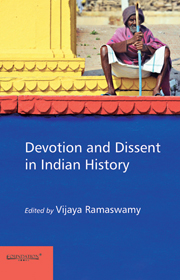Book contents
- Frontmatter
- Dedication
- Contents
- List of Tables and Figures
- Foreword
- Preface
- Introduction: Locating Devotion in Dissent and Dissent in Devotion A Thematic Overview
- Introduction
- 1 Parsing of Devotion and Dissent
- 2 Dissent and Protest in Early Indian Buddhism with Special Reference to Devadatta
- 3 Devotion and Dissent in Hunter's Bhakti
- 4 Devotion and Dissent
- 5 Dissent Within
- 6 Women in Love
- 7 Dissenting Voices
- 8 Dissent in Kabir and the Kabir Panth
- 9 Devotion and Dissent of Punjabi Dalit Sant Poets
- 10 Protest and Counter-protest
- 11 Fakirs of Bengal
- 12 Music in Chishti Sufism
- 13 Dissenting the Dominant
- 14 Devotion and Dissent within the Catholic Church in Late Colonial Bengal
- 15 Narratives of Travel, Voices of Dissent and Attacks on the Colonial Church Fabric of the European Missionaries
- 16 Devotion and Dissent in Narayana Guru
- 17 Sree Narayana Guru's Idioms of the Spiritual and the Worldly
- Contributors
- Index
2 - Dissent and Protest in Early Indian Buddhism with Special Reference to Devadatta
from Introduction: Locating Devotion in Dissent and Dissent in Devotion A Thematic Overview
Published online by Cambridge University Press: 05 October 2014
- Frontmatter
- Dedication
- Contents
- List of Tables and Figures
- Foreword
- Preface
- Introduction: Locating Devotion in Dissent and Dissent in Devotion A Thematic Overview
- Introduction
- 1 Parsing of Devotion and Dissent
- 2 Dissent and Protest in Early Indian Buddhism with Special Reference to Devadatta
- 3 Devotion and Dissent in Hunter's Bhakti
- 4 Devotion and Dissent
- 5 Dissent Within
- 6 Women in Love
- 7 Dissenting Voices
- 8 Dissent in Kabir and the Kabir Panth
- 9 Devotion and Dissent of Punjabi Dalit Sant Poets
- 10 Protest and Counter-protest
- 11 Fakirs of Bengal
- 12 Music in Chishti Sufism
- 13 Dissenting the Dominant
- 14 Devotion and Dissent within the Catholic Church in Late Colonial Bengal
- 15 Narratives of Travel, Voices of Dissent and Attacks on the Colonial Church Fabric of the European Missionaries
- 16 Devotion and Dissent in Narayana Guru
- 17 Sree Narayana Guru's Idioms of the Spiritual and the Worldly
- Contributors
- Index
Summary
The Buddha and Devadatta were cross-cousins. Devadatta and Bhaddakaccānā/Bhaddakaccā were respectively the son and daughter of Sākyan Suppabuddha and Amitā. Amitā was the sister of the Buddha's father, Suddhodana. The Buddha's mother, Māyā/Mahāmāyā, and stepmother, Pajāpatī Gotamī, were Suppabuddha's sisters. According to the Pāli texts, Bhaddakaccānā was married to Prince Siddhattha, the would-be Buddha. Devadatta entered the Saṃgha when the Buddha visited Kapilavatthu shortly after Enlightenment. He appears to have begun his career quite impressively as a monk. During the very first Vassāvāsa that followed his entry into the Saṃgha, Devadatta acquired the power of iddhi, possible to those who are still of the world (puthujjanika-iddhi). According to the account, as a result of this achievement, the prestige of Devadatta grew tremendously and he came to acquire great respect within the Saṃgha. In fact, elsewhere in the Pāli Nikāyas, Devadatta is praised as a quintessential example of an ideal monk, who had the right views and preached the correct dhamma. Sāriputta lavished praises on him saying: ‘Godhīputta is of great psychic power, Godhīputta is of great splendour’. The Buddha also praised Devadatta and included him amongst those eleven Elders who were particularly praiseworthy. In fact, the Buddha went so far as to call Devadatta and the others as the ones who had ‘put away evil, who have destroyed the fetters, the wise ones’.
- Type
- Chapter
- Information
- Devotion and Dissent in Indian History , pp. 31 - 48Publisher: Foundation BooksPrint publication year: 2014
- 2
- Cited by



